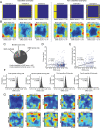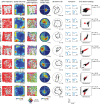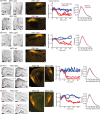Entorhinal-retrosplenial circuits for allocentric-egocentric transformation of boundary coding
- PMID: 33138915
- PMCID: PMC7609058
- DOI: 10.7554/eLife.59816
Entorhinal-retrosplenial circuits for allocentric-egocentric transformation of boundary coding
Abstract
Spatial navigation requires landmark coding from two perspectives, relying on viewpoint-invariant and self-referenced representations. The brain encodes information within each reference frame but their interactions and functional dependency remains unclear. Here we investigate the relationship between neurons in the rat's retrosplenial cortex (RSC) and entorhinal cortex (MEC) that increase firing near boundaries of space. Border cells in RSC specifically encode walls, but not objects, and are sensitive to the animal's direction to nearby borders. These egocentric representations are generated independent of visual or whisker sensation but are affected by inputs from MEC that contains allocentric spatial cells. Pharmaco- and optogenetic inhibition of MEC led to a disruption of border coding in RSC, but not vice versa, indicating allocentric-to-egocentric transformation. Finally, RSC border cells fire prospective to the animal's next motion, unlike those in MEC, revealing the MEC-RSC pathway as an extended border coding circuit that implements coordinate transformation to guide navigation behavior.
Keywords: border cell; egocentric-allocentric transformation; entorhinal cortex; neuroscience; rat; retrosplenial cortex.
© 2020, van Wijngaarden et al.
Conflict of interest statement
Jv, SB, HI No competing interests declared
Figures





















References
Publication types
MeSH terms
Associated data
Grants and funding
LinkOut - more resources
Full Text Sources
Other Literature Sources

